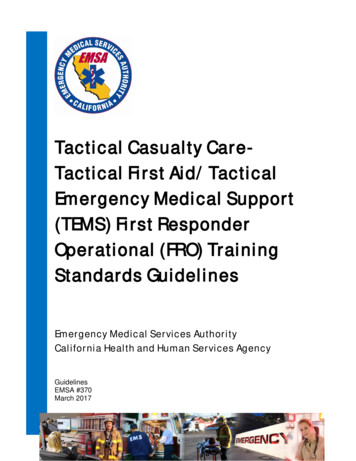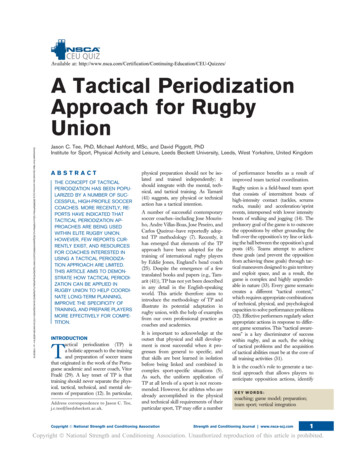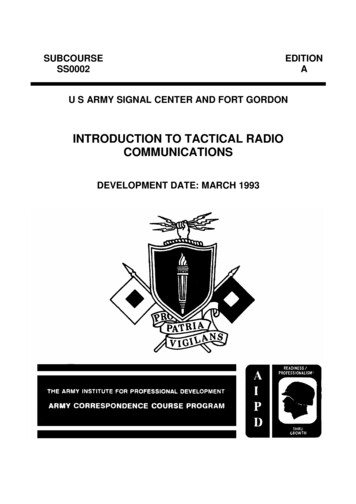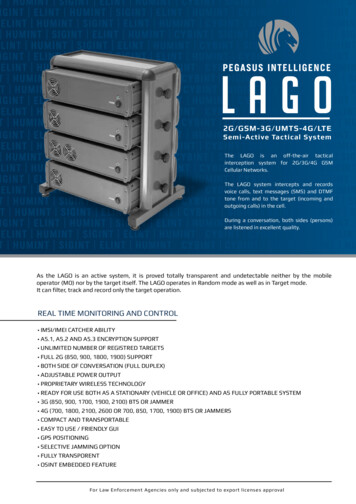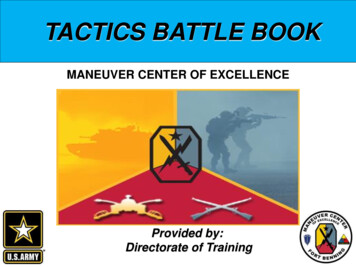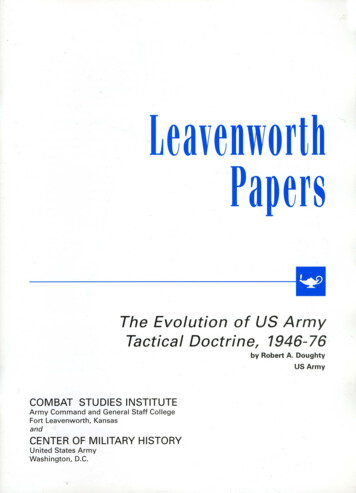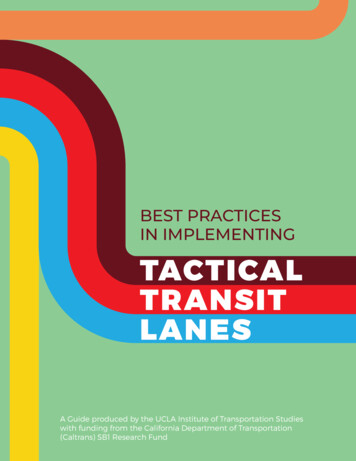
Transcription
BEST PRACTICESIN IMPLEMENTINGTACTICALTRANSITLANESA Guide produced by the UCLA Institute of Transportation Studieswith funding from the California Department of Transportation(Caltrans) SB1 Research Fund
About ths GuideThis guide is intended for planners interested in implementingTactical Transit Lanes, particularly first-time lanes. Its focus is on theimplementation, i.e., the planning and outreach considerations of theproject as opposed to design, for which other recent resources exist (seeOther Resources section).The content of this guide is drawn from interviews with 24 plannersfrom twenty city departments and agencies conducted between August2018 and January 2019. It is also informed by the results of a survey of81 professionals conducted in January 2019, with 26 respondents, as wellas by the researchers’ review of relevant sources such as news articles,agency websites, industry blogs, and other reports.This guide is produced by the UCLA Institute of Transportation Studies,with funding received by the University of California Institute ofTransportation Studies Mobility Research Program, funded by the RoadRepair and Accountability Act of 2017 (SB 1). The authors would like tothank the State of California for its support of university-based research,and especially for the funding provided in support of this project.About the UCLA Institute of Transportation StudiesThe mission of the UCLA Institute of Transportation Studies (UCLA ITS) –one of the leading transportation policy research centers in the UnitedStates – is to support and advance cutting-edge research, the highestquality education, and meaningful and influential civic engagement onthe many pressing transportation issues facing our cities, state, nation, andworld today. UCLA ITS is a non-endowed research center housed in theUCLA Luskin School of Public Affairs, and ITS faculty, staff, and studentsregularly collaborate with and receive support from the UCLA LewisCenter for Regional Policy Studies. ITS is a proud partner in the PacificSouthwest Region 9 University Transportation Center, a federally-fundedresearch network with seven other universities.
BEST PRACTICESIN IMPLEMENTINGTACTICALTRANSITLANESUCLA ITS with support from SB1February 2019
AcknowledgementsThis project was made possible by funding from the California Departmentof Transportation (Caltrans) SB 1 Research Program.Much of this guide’s content was informed by interviews with, and/orcontributions, from the following people:Greg Harper, Alameda-Contra Costa Transit DistrictKristina Evanoff, City and County of DenverRyan Billings, City and County of DenverJennifer Raitt, Town of Arlington, MATegin Teich, City of Cambridge, MAJay Monty, City of Everett, MAJenifer Hager, City of MinneapolisPeter James, City of Santa MonicaJonathan Dong, City of SeattleIrin Limargo, King County MetroOwen Kehoe, King County MetroLindsey Kiner, LK PlanningJody Litvak, Los Angeles County Metropolitan Transportation AuthorityDavid Mieger, Los Angeles County Metropolitan Transportation AuthorityHolly Arnold, Maryland Transit AdministrationPatrick McMahon, Maryland Transit AdministrationMichael Mechtenberg, Metro Transit (Minnesota)Eric Carlson, Orange County Transportation AuthorityLiz Brisson, San Francisco Municipal Transportation AgencyMichael Rhodes, San Francisco Municipal Transportation AgencyAdam Burger, Santa Clara Valley Transportation AuthorityTim McCormick, Santa Monica Big Blue BusTed Meyer, Southwest Ohio Regional Transit AuthorityAndrew Cobian, UCLAShyam Kannan, Washington Metropolitan Area Transit AuthorityNaomi Klein, Westchester CountyErrors are the authors’ own.
CONTENTSAbout Tactical Transit Lanes. 1What is a Tactical Transit Lane?. 1TTL vs. BRT.2Where TTLs make sense. 4Who implements TTLs?.5Recent trends.5TTL Benefits. 9Planning a TTL. 11Strategic Considerations.11Political Support.11Community Context.11Partnerships. 13Costs and Funding. 13Using Data.16Pilot Projects.17Public Engagement and Outreach.20Abbreviated or no outreach.20Public meetings.20Door-to-door outreach.21Online outreach.21Videos.21Surveys. 22Community Design. 22Messaging. 23Cite transit-first policies (or consider testing them). 23Put the benefits on the map . 23Describe benefits in riders’ (and cyclists’) terms. 24Quote benefits from similar projects. 24
Design Considerations. 24Lane demarcation. 24Cones.25Signage and striping.25Red-painted lanes.26Hours of operation. 27Other vehicle access. 27Common Challenges. 29Pre-Implementation. 29Parking.29Access/loading zones.29Community e Studies. 33The Cone Pilot: Everett, MA and Minneapolis. 34The “Quick Build” Pilot: Cambridge, MA. 36The Comprehensive Project: Santa Monica. 37The Network Project: Baltimore and San Francisco. 38The “Long TTL”: Los Angeles and Santa Clara Valley. 39Takeaways. 40Other Resources.42Acknowledgements.44Credits.45
ABOUT TACTICALTRANSIT LANES
What is a Tactical Transit Lane?TransitCenter coined the term “tactical transit.” Borrowing from the notion of tactical urbanism1,tactical transit references “low cost, agile alternatives to jump start virtuous cycles of increasing busridership by speeding up travel times, improving [the] passenger experience and enhancing overallperceptions of riding the bus.”2A Tactical Transit Lane (“TTL”) is a bus only lane tactically implemented in dense, congested areasto speed up transit without major capital improvements. Many projects described by other names,such as dedicated bus lanes, transit corridors, bus priority lanes, and business and transit access (BAT)lanes, are TTLs.TransitCenter’s tactical transit approach. Courtesy of TransitCenterTTLs can be as short as a block or as long as several miles, but most recent TTLs are approximatelyone mile long.Especially compared to other capacity-enhancing projects, TTLs are quick, low-cost, and reversible.Though some are planned as permanent projects, many recent TTLs have been pilot projects thatgive planners a low-stakes way to learn how a permanent improvement would work. Some have beenquick pilots or “cone” pilot projects that are in place only a few weeks or in one case, a few days.Table 1 outlines these types of TTLs.1 Lydon, M., Garcia, A., & Duany, A. (2015). Tactical urbanism: short-term action for long-term change. Washington, DC: Island Press.2 TransitCenter. (2016, December 19). Why Tactical Transit is the Next Big Thing. Retrieved February 7, 2019, from ransit-is-the-next-big-thing/1
Table 1: Categories of TTLTTL TypeInstallationPlannedlifespanPublic ProcessExamplesBaltimorePermanentPermanent lanes,often red-paintedChicagoIndefiniteTraditional outreachLos AngelesSan FranciscoSanta MonicaBerkeley, CASemi-permanentlanes often stripedor paintedPilot6 months - 1year; sometimesindefiniteUsually traditionaloutreachCambridge, MACincinnatiPittsburghQuick Pilot or“Cone Pilot”Temporary andshort-term; lanesdemarcated withconesArlington, MA3 days - 1 monthAbbreviated;sometimes none (“thepilot is the process”)Boston, MAEverett, MAMinneapolisBoston’s “cone pilot” on Washington Avenue. Photo courtesy of LivableStreets.TTL vs. BRTAlthough TTLs and BRT both use bus only lanes for the purpose of giving transit priority, they aredistinct in their characteristics and their typical contexts. Unlike TTLs, which are a road treatment,BRTs are also a program for transit planning and operations. Table 2 delineates TTL from BRT projects.2
Table 2: TTL and BRT ComparedTTLBRTTypical length0.5 - 1 mile1.9 miles*Typical contextDense to very dense urban or urbancore areas; high-traffic streetsModerately dense areas outsideurban core, sometimes suburban1. Increase transit speeds2. Support transit-orienteddevelopment (TOD) orimproved land use3. Increase ridership4. Improve transit’s image/brand5. Increase person throughput1. Increase transit speeds2. Reduce transit congestionat “pinch points”3. Improve pedestrian/ridersafety4. Increase ridership5. Increase person throughputCommon “top 3” goals,ranked3ExampleMarket Street, San FranciscoOrange Line, Los AngelesRoutes servedMultiple, existingUsually one, often new and/orbranded (e.g., “Orange Line”)Bus only lane(s)YesYes*; can also be separate transitwayLane treatmentOften red-paintedUsually white-striped and signedOther vehicle accessOften bicycles, right-turning traffic;sometimes private buses/shuttles,taxisUsually no other modes allowedBranded serviceNoYesTransit signal priority(TSP)SometimesUsuallyEnhanced stops/stationsSometimesYesEnhanced ntsRarelyUsuallyReduced stopsSometimesYesTypical cost per mile 100,000 1M PilotableYesNo*The “BRT Standard” established by the Institute for Transportation and Development Policy (IDTP) defines BRTs as having aminimum of 3 kilometers (1.9 miles) of dedicated bus lanes.3 Informed by a January 2019 survey of 26 TTL and BRT planners. This question was answered by 12 TTL and 5 BRT planners;respondents chose their project’s top 3 goals and ranked them; the results are weighted by rank.3
Where TTLs make senseTTLs are appropriate in dense, congestedareas when and where transit speeds and/orheadway reliability are a concern. In especiallycongested contexts, short TTLs of a few blocks(such as Berkeley, California’s Bancroft Way)can significantly increase the reliability andappeal of transit service. Most TTLs have beeninstalled on segments of about one mile,traveled on by 10,000 or more riders a day, onmultiple routes. Table 3 includes informationon the characteristics of recent TTLs.Many TTLs are in “commuter corridors” whereremoving transit vehicles from peak-hourtraffic yields the greatest benefits. Wherecongestion is not all day and not bi-directional,TTLs can operate in one direction in themorning peak and another in the evening.TTLS are appropriate in.dense, congested areaswhere concerns include.transit speedsheadway reliability4Fairfax Avenue runs through Fairfax Village inLos Angeles, a dense, congested urban contextappropriate for a TTL. Photo by Roberto Nickson onUnsplash
Arlington, MA cone pilot TTL.Cone pilots are a TTL planningmethod where the “pilot [is] theprocess” implementing a TTLin the real world and looking atactual resulting service benefits.Photo: Ann Ringwood, WickedLocalWho implements TTLs?Most recent TTL projects have beencollaborations between the area’s transitagency and the city and/or county planningor public works department. Large and smallcities have implemented TTLs; all are inmetropolitan areas.Recent trendsNicollet Mall, constructed in 1967 in Minneapolisoffers an example of a legacy transitway. Photo: MattJohnson via Flickr, CC BY-NC-SA 2.0Geary St offers an example of a permenent bus lane indowntown San Francisco. Photo: SFMTA.Bus lanes are not new. Many “legacy” busonly lanes date to the 1970s or earlier andwere built alongside changes in downtownspecific general traffic patterns (ofteninvolving one-way streets) or in some casesas transitways. What has emerged as a recenttrend is the use of bus lanes being installedoutside downtowns, in targeted locationschosen for the improvements they make tobus operations on a specific route segment,and for the bicycle connectivity that they canalso provide. As discussed above, the term“TTL” describes these newer tactical uses ofbus lanes. A full list of recent TTLs is providedin Table 3.5
Table 3: Recent TTLs of All TypesLocationYear Openedor PilotedLengthPilotHoursRiders/day20180.25 milesYes6-9 am in onedirection10,000 Baltimore: BaltimoreLink2016-20175 mi. on 9 streets;each 0.25-1 mi.7 mi. of TTLplanned.NoMost are 24/7N/ABerkeley, CA: BancroftWay20180.25 miles (3blocks)Yes24/710,000Boston/Roslindale:Washington Street2017-20181.25 milesYes5-9 am NB19,0004Cambridge/Watertown,MA20180.9 milesYes24/712,000Chicago: Loop Link20152 milesNo24/7Cincinnati: Main Street20180.5 milesYes7-9 am, 4-6 pm11,0005Denver: Broadway/LincolnCorridor20173.5 milesconverted; 0.25miles new laneYes24/7N/AEverett, MA20161 mileYesLos Angeles: WilshireBoulevard2013-20157.7 miles total(discontinuous)No7-9 am, 4-7 pm45,000Miami, FL: First Street20170.5 milesYes24/7N/AMinneapolis: HennepinAvenue20180.5 milesYes6-10 am NB;3-7:30p SB400 buses;3,300 brdngs incorridorPittsburgh: LibertyAvenue20170.5 milesYes6 am - 6 pm6,000San Francisco:Muni RapidNetwork2014-current50 TTLs plannedsystemwideNoVaries172,000 (RapidBus Network)Santa Monica, CA: LincolnBoulevard20171 mileNo7-9 am NB;4-7 pm SBN/ASeattle: 3rd Avenue20180.9 milesNo6 am - 7 pm100,000; 2,500buses6Washington, DC: GeorgiaAvenue20160.3 milesYes7 am - 10 pm,Mon-Sat20,000Arlington, MA10,0004 Boston Makes Its Bus Lane Experiment Permanent. (2018, June 8). Retrieved January 23, 2019, from s-its-bus-lane-experiment-permanent/5 Cincinnati Bus Riders Finally Get A Lane of their Own. (2018, November 5). Retrieved January 23, 2019, from bus-riders-finally-get-a-lane-of-their-own/6
Table 3: Recent TTLs of All Types (cont.)Location (cont.)RoutesArlington, MA3Baltimore:BaltimoreLink6 Parking removed/Other featureschangedYesIncluded signal phase changes, TSP, and queuejumpYes; added in someplacesSystem-wide overhaul with criteria for TTLs; 6 newfull-time lanes; 2 enhanced full-time lanes; 2 peakhour lanesOne-wayBerkeley, CA: BancroftWay9Minor changesBoston/Roslindale:Washington Street6YesCambridge/Watertown, MA2No“Quick Build” in two-weeksChicago: Loop Link6YesProject includes bike lanes, stations, and new bushubCincinnati: MainStreet10 YesSpurred by grassroots advocacy group (Better BusCoalition)Denver: Broadway/Lincoln Corridor10 No“Blocky” red paint being tested. Full-time lanesconverted from part-time lanes; lane extensionEverett, MA5YesNo prior outreachLos Angeles: WilshireBoulevard2YesIncluded street, signal, and signage improvementsalong 9.9-mile corridorMiami, FL: First Street4NoPart of “Complete Streets” projectMinneapolis:Hennepin Avenue4YesTuesday-Thursday onlyNo net decrease:restrictions liftednearbyPittsburgh: LibertyAvenue10 San Francisco:MuniRapid Network4 YesBus bulbs, pedestrian bulbs and other safetyfeatures, stop consolidation/optimization, upgradedTSP2YesStreetscape improvements10 NoAll lanes are bus only2YesSanta Monica, CA:Lincoln BoulevardSeattle: 3rd AvenueWashington, DC:Georgia Avenue6 Bus-only hours on Seattle’s busy 3rd Avenue being extended. (2018, July 27). Retrieved January 23, 2019, from eattles-busy-3rd-avenue-being-extended/7
TACTICALTRANSIT LANEBENEFITS
Increased transit vehicle speeds: Although they are short, TTLs can produce outsizedtravel time savings. Recent TTLs, such as Boston’s and Everett’s, have reduced peak congestiontravel times by 20-28 percent.7Decreased variability in travel times: TTLs can produce dramatic decreases in thevariability of transit travel times particularly in peak-hour congestion, improving operatingefficiency for the agency and quality of service for the rider. See Figure 2 for a summary oftravel time improvements in the Town of Arlington’s pilot.Variability ImprovementTravel time variability10.09.08.0Time (min)Route79/3507.06.0Diff 90th and 50th Before5.04.0Diff 90th and 50th After3.02.01.00.0678910111213Hour of the day141516171819Travel time variability8.07.0Route 77Time (min)6.05.0Diff 90th and 50th Before4.0Diff 90th and 50th After3.02.01.00.0678910111213Hour of the day141516171819The Town of Arlington found travel time variability was significantly lower after their TTL pilot wasinstalled (red bars) than before (orange bars). Source: Town of Arlington.8Relatively quick implementation: Cone pilots, such as Everett’s, can be organizedwithin weeks and installed within days; red-painted lane “quick builds”, such asCambridge’s, can be installed in as few as two weeks.Potential ridership gains: a summary of research suggests that bus lanes that reducetotal transit door-to-door travel times by 5-15% will “by themselves increase urban peakridership 2-9%.”9 The City of Denver found that ridership increased 2.8% in the first sixmonths of their TTLs’ operation, even though travel speed improvements were relativelymodest (3-6%), likely due to the TTL being an expansion of existing lanes that had alreadybeen operational during peak hours when TTLs yield the greatest benefits.Safer for cyclists: TTLs give cyclists a buffer between parked and moving cars.7 Arlington’s TTL produced savings of 5-6 minutes, a fifty percent reduction in travel time (for 50th percentile trips).8 Amstutz, D. (2018). Massachusetts Avenue Bus Priority Pilot: Public Forum. Arlington, MA: Town of Arlington. Retrieved id 446429 Litman, T. (2016). When Are Bus Lanes Warranted?: Considering Economic Efficiency, Social Equity and Strategic PlanningGoals. Victoria Transport Policy Institute. Retrieved from http://www.vtpi.org/blw.pdf9
PLANNING ATACTICAL TRANSITLANE
Strategic ConsiderationsLike most public works projects, TTLs typically attract interest from the community affected. Likemany transit projects, the community affected is not necessarily the community that stands to benefitfrom the project’s improvements, which can present a political challenge.Political SupportThe support of local elected officials is critical. Depending on your project’s impacts and yourcommunity’s experience with past projects, supporting the project could be politically risky for yourelected officials. Many planners who have implemented TTLs new to their city say that having highquality and specific data on the projected benefits for elected officials to see and use is helpful. Personthroughput data is especially helpful.Some TTL planners have found that their cities’ decision-makers are not necessarily knowledgeableabout transit and do not know how it works, how many people use it, or even how people use it.Worse, they sometimes had incorrect assumptions. In such cases, it can be helpful to organize fieldtrips or site visits for officials to see the TTL context, where it will be installed, and what problems itwill address.While top-down political support is vital, it is also important to recognize when a bottom-upcommunity process is essential to project implementation. In one example, a disconnect between theprocess that the city’s planners pursued and the one their community nearly thwarted the project:Although the city council had approved the transit lane, an official’s remark at a public meeting that“it doesn’t matter because the council already approved this” galvanized opposition that delayedimplementation by many years. When planners re-engaged the community several years later,they found that while the core group of opponents persisted, they were able to engage many moresupporters by sharing a positive vision for the corridor.Community ContextKnowing your community’s preferences at the start is helpful. Does your community haveexpectations about what a project should look like or what input they will be able to give? Is yourcommunity open to experiments or pilot projects if it saves money or delivers results faster? Theanswers to these types of questions appropriately inform such decisions regarding what elements yourproject will include, what scale it should have, and whether a pilot project is suitable (and if so, whattype of pilot).Table 4 outlines some design and implementation choices driven by community context. Since eachcommunity context is different, suitable approaches to TTLs will vary widely. There is no one-size fitsall approach to TTLs. Table 5 lists a few examples of cities with TTLs and the implementation choicesthat fit their contexts.11
Table 4: Community context drives implementation choicesCommunity ContextCommunityPreferences Results-oriented Process-oriented Comfort withinnovationProject Goals Reduce corridorperson -delay Safer bike lanes Communityinvestment Parking availabilityImplementation ChoicesProject Scope Transit SignalPriority (TSP) Streetscape Lane treatmenttypePilot Type None Quick FullEngagement No outreach Abbreviatedoutreach ExtensiveoutreachTable 5: Examples of community contexts and implementation choices madeCommunity ContextImplementationEverett, MA Results-oriented Comfortable with innovation Wants faster transit Quick pilot(eventual permanence) No outreach before pilotSanta Monica, CA Process-oriented Wants safer bike lanes andcommunity investment Permanent (no pilot) Streetscape improvements Traditional outreachArlington, MA Results-oriented Wants faster transit Wants community investment Full pilot Streetscape improvements(permanent) Traditional outreachHypothetical Process-oriented Comfortable with innovation Wants faster transit Full pilot No outreach before pilotAs planners everywhere know, voices of opposition can have disproportionate effect proportion onthe process. Identify early on where sensitive areas of the project are and “who will care”. Liz Brisson,Major Corridor Managers at SFMTA advises: “Look at your land use map and you can figure out whoyou need to talk to.”Cyclists, both organized and not, have been major advocates of recent TTL projects, and in severalcases, were the foremost advocates for TTLs, some of which started out as bike lanes. In SantaMonica, cyclists were important advocates for the bus only lane – identifying it as their top priorityat public meetings – even though the city currently prohibits cyclists from using the TTL. Becausebuses are wide, TTLs stretch parking lanes from their typical 7-8 feet to a bus-accommodating 11-12feet, opening 4-5 feet of new roadway space for cyclists to share with buses (if allowed) or to use whenthe TTL is not operational and is a parking lane. If your city has a community of cyclists, engage themearly in your planning.12
TTLs typically expand parking lanes, making room for bike lanes and giving cyclists a new buffer betweenparked cars and moving vehicles. Photo courtesy of City of Everett, MA.PartnershipsTTLs are often installed by a city department while thebuses that use them are operated by a separate city or“If your city has acounty agency. A collaborative relationship is essentialcommunity of cyclists,for a project’s success, particularly if it is politically risky.Planners who have succeeded in collaborative TTL projectsengage them early insay that a shared understanding of a project combined withyour planning”shared ownership (“our project”) is important. Unifiedmessaging from both organizations is also importantto inspire public confidence in, and understanding of, the project. For projects that involve multiplejurisdictions, creating a “Project Development Team” with representatives from each city can promoteunderstanding and collaboration.Costs and FundingTTLs are relatively low-cost projects. Private foundations have supported many TTLs and are apotential funding source. Grants of 100,000 from the Barr Foundation, for example, funded TTLpilots in Arlington, Cambridge, and Boston, while a 150,000 grant from the R.K. Mellon Foundationfunded one in Pittsburgh. Table 6 shows costs and funding sources, where known.13
Table 6: TTL Costs and Funding Sources10LocationYearOpened orPilotedApprox.LengthLaneDemarcationArlington, MA:Massachusetts Avenue20180.25 milesConesBerkeley, CA: Bancroft Way20180.25 miles (3blocks)Red-painted lanesBoston/Roslindale:Washington Street201720181.25 milesConesCambridge/Watertown, MA:Mt. Auburn Street20180.9 milesRed-painted lanesCincinnati: Main Street20180.5 milesStriping and signageEverett, MA: Broadway20161 mileCones; later redpainted lanesMiami, FL: First Street20170.5 milesRed-painted lanesMinneapolis: HennepinAvenue20181.1 miles(split-segmentstotal)ConesPittsburgh: Liberty Avenue20170.5 milesRed-painted lanesSanta Monica: LincolnBoulevard20171 mileStriping and signage10 TTLs with no available cost or funding data are omitted.14
Table 6: TTL Costs and Funding Sources (cont.)Location(cont.)Capital CostFunding SourceArlington, MA:MassachusettsAvenue 100,000, including TSP, signal changesand other enhancementsPrivate foundation grantBerkeley, CA:Bancroft Way 122,000City funds; UC Berkeley afunding partnerBoston/Roslindale:WashingtonStreet 100,000Private foundation grantCambridge/Watertown,MA: Mt. AuburnStreet 120,000 for water-based (temporary) redpaint, markings, signs; 27,000 for signals and TSP; 25,000 for enforcement; 10,000 for consultant work;(Some signal equipment cos
BEST PRACTICES IN IMPLEMENTING A Guide produced by the UCLA Institute of Transportation Studies with funding from the California Department of Transportation (Caltrans) SB1 Research Fund. About ths Guide This guide is intended for planners interested in implementing Tactical Transit Lanes, particularly first-time lanes. Its focus is on the implementation, i.e., the planning and outreach .
